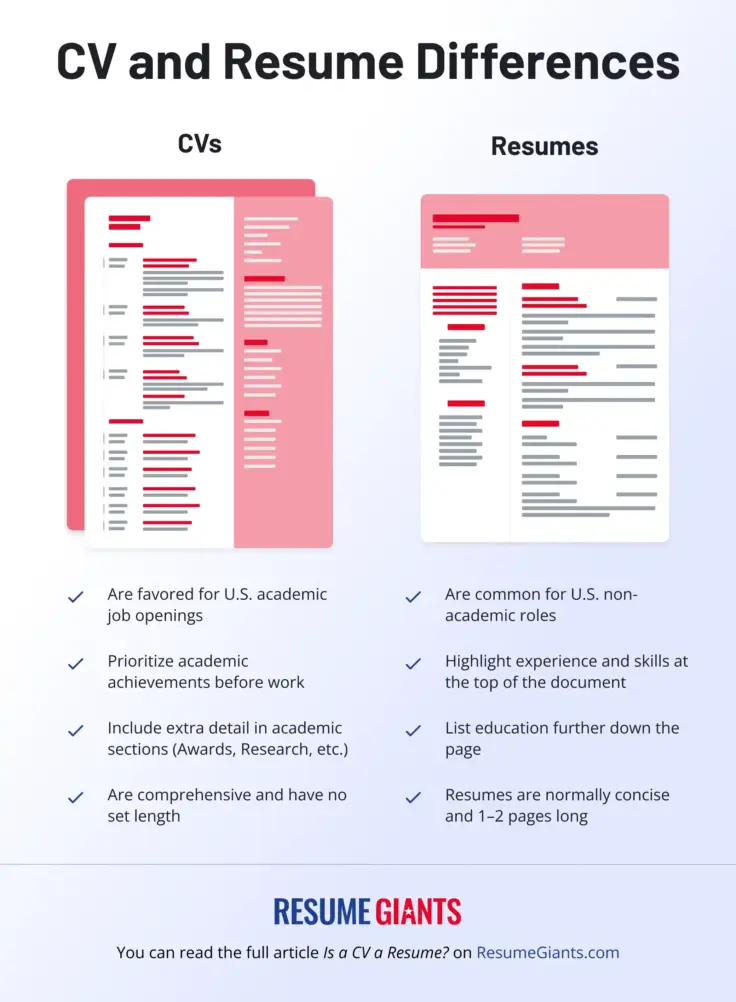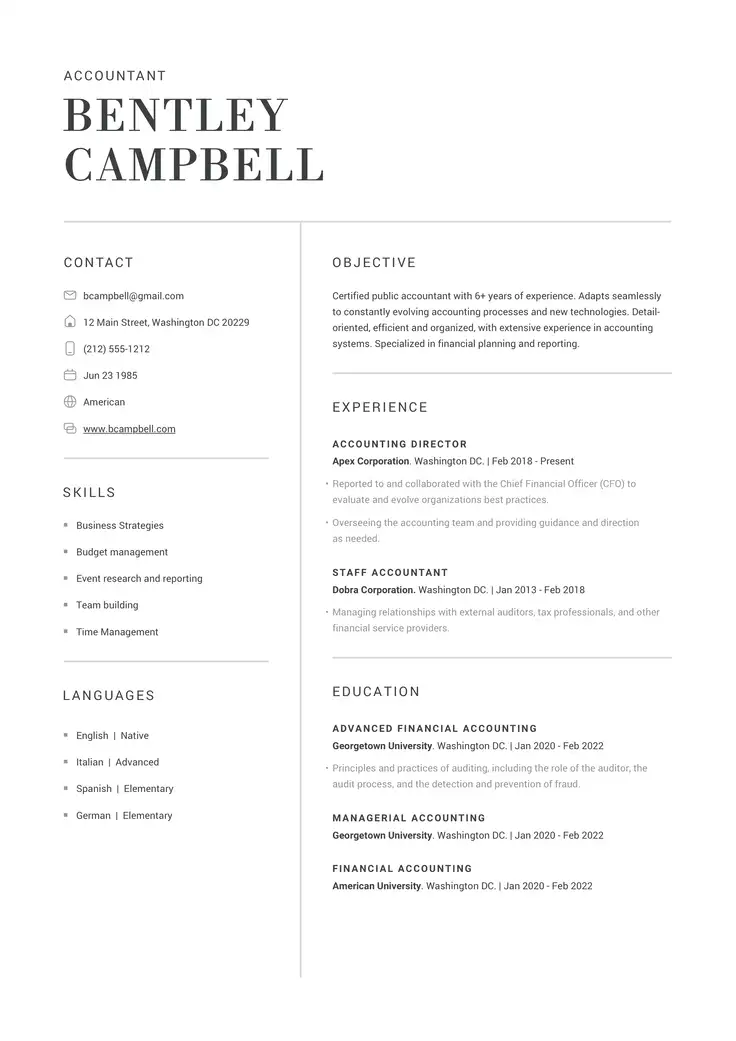Depending on your career and where you live, a resume or a CV could be a foreign concept.
While we almost exclusively use the term resume in the United States, in countries like the United Kingdom, the term CV is the standard.
In some countries, like India, both terms are used interchangeably.
So, if you’re asking yourself, “How do I turn my resume into a CV?” or you’re applying for a position that prefers a curriculum vitae, you’ll want to understand the following:
- The differences between a CV and a resume in the U.S.
- When to use a CV or resume
- What information to include in each
- What to focus on in a CV or resume if you want to work in the U.S.
Whichever you choose to draft, our guide on these differences and our handy online resume builder can help you create a solid application in minutes.
Main Differences Between a Resume and CVs
Both CVs and resumes describe your qualifications and career so far.
However, there are 3 key differences:
- Length
- Industry where it’s used
- Level of detail
Here is a quick comparison of the two documents:

| CVs | Resumes |
|---|---|
| Favored for U.S. academic job openings | Are common for U.S. non-academic roles |
| Prioritize academic achievements before work | Highlight experience and skills at the top of the document |
| Include extra details in academic sections (Awards, research, etc.) | List education further down the page |
| Are comprehensive and have no set length | Resumes are normally concise and 1 to 2 pages long |
The biggest difference you’ll notice is the length. While a resume may only be one or two pages, a curriculum vitae can be as long as necessary.
A CV can be two pages or nine pages. The length depends on the extent of the candidate’s experience, education, and other relevant qualifications.
The highlighted points in a curriculum vitae are professional and academic achievements, while a resume focuses more on work history.
Where CVs and Resumes Are Commonly Requested
If you’re deciding between drafting a CV or a resume, think about where you’re applying and which industry or sector the job belongs to.
In the United States, you’ll typically be asked for a resume, especially if you work in a non-academic field.
By using this document you can show off your experience to hiring managers, whether it includes full-time jobs, volunteer roles, internship positions, or awards you’ve received.
On the other hand, the companies or organizations that usually request curriculum vitae have less competition than you’d see in industrial sectors.
Using a CV to apply for work is recommended if you:
- Work in an academic position
- Work outside of the United States and Canada
If either of these situations applies to you, then submitting a CV is definitely a better option than a resume.
Since academic information and research are given more emphasis in a CV, you should use them when applying for any academic roles.
Writing a CV for a Job Outside the U.S.
If you’re planning on working abroad, you’ll likely only see CVs mentioned in job descriptions.
These are typical areas where you’ll need to submit a curriculum vitae:
- United Kingdom
- The European Union
- New Zealand
- LATAM
- Asian countries (China, Japan, Singapore, etc.)
-
💡 Our expert’s advice

Different countries have their own unique CV format. Make sure to follow the format used in the country you’re applying to.
Look for examples online from trusted employment resources, such as the UK government’s National Career Service pages.
What Should Be Included in a North American CV?
As we mentioned, in North America a CV is typically longer than a standard resume.
If you have a resume but need to turn it into a CV, you’ll need to add more information, especially related to your academic accomplishments.
However, it’s important to remember, just because it will likely end up longer you shouldn’t overdo it.
To help you out, we’ll break down each section of a CV in detail and explain what should be included.
1. Contact Information
This is pretty basic information, including your preferred methods of contact.
It’s best to have your professional or cell phone number. Also, list your email address. Always make sure your email address is professional in nature, preferably including your name.
Some recruiters don’t leave voicemails, so it’s important to provide them with an email to follow up in case you don’t answer.
2. Your Summary
Your summary statement will be a short introductory paragraph that outlines the value you can bring to the job you are applying to. It should briefly mention your accomplishments and experience.
Try to keep it to 2 or 3 sentences.
You can try using our free AI summary maker to help you make a professional, succinct summary for your CV. Just provide your desired job decision, and your summary will be ready instantly.
3. Education
The education section should go into full detail about your academic credentials. That means listing all of your college degrees and relevant courses completed.
Include your bachelor’s and master’s degrees, and any doctorates if you have them.
Also, include your GPA and any honors if they are noteworthy; for example, if your GPA was over 3.6, you should add it.
4. Academic Achievements
This is a broad topic, but you would actually break them down into their own sections for formatting purposes. Academic achievements include:
- Details of publications you have written or contributed to
- Books you have written
- Cowriting
- Awards and accolades
- Grants
- Conferences you attended and spoke at, if applicable
5. Professional and Academic Experiences
Experiences in the academic world are broad as well. If you have any teaching or post-graduate experience, it can be useful to add information.
You can break up the different areas like this:
- Teaching
- Lab
- Research
- Post Graduate Work
This section should be the biggest. While you want the whole thing to be written well, be sure to give 1000% effort to these sections!
6. Languages and Skills
As speaking another language is considered an important skill, you can list any that you speak within the same skills section.
-
💡 Our expert’s advice

Depending on what the job description asks for, you may also want to highlight the languages you speak in the summary, too.
Listing languages is especially important when you’re applying for a job in a country with a different native language. Keep in mind if you go to Europe, it will be helpful to list any of your secondary languages in CEFR format.
The skills you present here should include your technical abilities as well as soft skills. These could be related to research methods, computing and IT, management, leadership, problem-solving, data analysis, etc.
If you need some ideas for this section, you can use our free AI skills generator to help. This tool instantly gives you a list of the most in-demand skills in your industry.
What to Include in Your Resume
What you include on your resume will be shorter than on a CVs, as the goal will be to sum up everything on 1 or 2 pages.
Here’s a quick table of what to include if you’re sticking to the standard North American resume format:
| Section | What To Include |
|---|---|
| Contact Information | Like the curriculum vitae, you’ll want to list your mobile or professional phone number. Also list your professional email. |
| Resume Summary | Nowadays, resume objectives are going out of style. Stick to a summary to briefly mention your work history and accomplishments. |
| Work Experience | This will be the bulk of the resume, where your relevant professional history. |
| Education, Skills, and Accolades | If you have experience, you won’t need to go into as much detail in this section as a CV would. However, you should still list your most important academic information. |
- Contact Information: Like the curriculum vitae, you’ll want to list your mobile or professional phone number. Also, list your professional email.
- Resume Summary: Nowadays, resume objectives are going out of style. Stick to a summary to briefly mention your work history and accomplishments.
- Work Experience: This will be the bulk of the resume, where you will provide your relevant professional history.
- Education, Skills, and Accolades: If you have experience, you won’t need to go into as much detail in this section as a CV would. However, you should still list your most important academic information.
Our full resume writing guide can give you more information on how to fill in each of these sections. You can also check out our resume examples for more specific sector-specific information.
Keep in mind, if you’re an entry-level applicant or have worked in a different field, you can focus more on your skills, especially any that you can use in your new sector.
Do You Need a Cover Letter When Applying With a CV?
Including a cover letter is always a good idea when applying, whether you use a CV or a resume. A well-written cover letter allows you to explain why you’re interested in the position and how your skills and experience match the role.
A strong cover letter can also help you stand out by showing motivation and attention to detail.
You can easily create one in minutes using our free AI cover letter generator, which adapts your letter to your experience and strengths, and the job you’re applying for.
Key Points
While CVs and resumes focus on different details, the objective is the same: To land you the job you want quickly.
When working on your application, remember that:
- CVs in the U.S. are more appropriate for academic job openings
- Resumes focus more on your work history
- Resumes are more common in the U.S.
- CVs are typical internationally, but each country may have its own preferred format
- Using tools like resume templates or a builder can make the process smoother
Now that you know the difference and how to write a professional version of both, you can draft a stunning resume at home or abroad and in any sector!
Related posts


